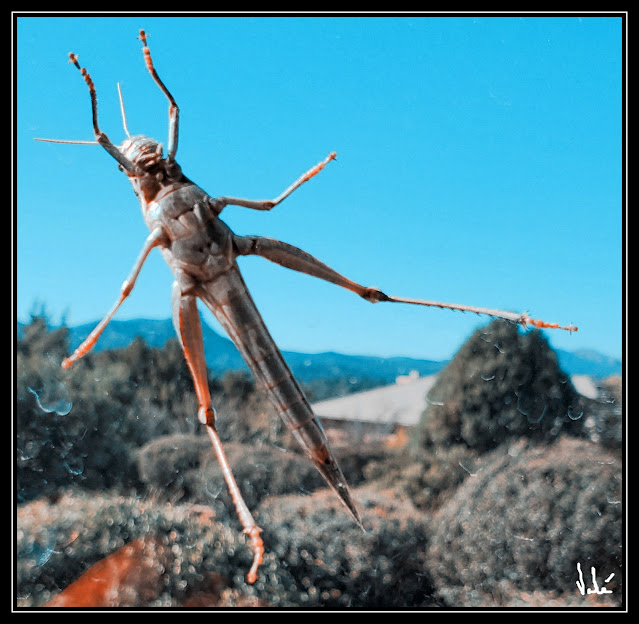A colleague from Belgium, commented on a photo I had
taken of plein air painters in Arizona. She
digitally “played” with the analogue original
and wrote:
“Your photography has a tendency toward
impressionism, just like your poetry. You play with light as you do with words
to take the focus off the theme you pursue. Sometimes I think of the song by
Gilbert Bécaud “L’important c’est la rose”
when I look at your work. Have you figured out what is the meaning of the rose
in that song?
Hmm. Back in the 1970s there were three giants of
French songs – Bécaud, Brel and Brassens. They were called ‘Les trios B de la chanson Française’. I
found it funny that my friend did not choose Brel for her commentary, as he is
the only Belgian out of the three!
So, I had to refresh my recollection of Bécaud’s lyrics.
Toi pour qui, donnant-donnant
J'ai chanté ces quelques lignes
Comme pour te faire un signe en passant
Dis à ton tour maintenant
Que la vie n'a d'importance
Que par une fleur qui danse
Sur le temps
L’important
C’est la rose l’important
So, the key lines seem to be:
It
is your turn to say now
That life doesn't matter
Than by a dancing flower
In the time
What
really counts is the rose
(The translation is mine)
Now, I was curious to guess why the rose was
important!
… Immediately, the poem by D.H. Lawrence “Gloire de Dijon” came to mind, perhaps
because of the French title and context, but also because he used the rose
called Gloire de Dijon to describe a sensual and sexual moment. The specific
lines are:
When
she rises in the morning
I linger to watch her;
She spreads the bath-cloth underneath the window
And the sunbeams catch her
Glistening white on the shoulders,
While down her sides the mellow
Golden shadow glows as
She stoops to the sponge, and her swung breasts
Sway like full-blown yellow
Gloire de Dijon roses.
This poem is often interpreted through impressionism,
like one would analyse a painting by Monet. It is fragmented, each line is
self-contained and self sufficient. It is like the effect of light and shadows
an impressionist painter pursues without focusing on a central theme.
Did Bécaud use the same style in his song, or is there
more than style that make the song mysterious?
The definition of impressionism is:
a style or movement in painting originating
in France in the 1860s, characterized by a concern with depicting the visual
impression of the moment, especially in terms of the shifting effect of light
and color.
And
a
literary or artistic style that seeks to capture a feeling or experience rather
than to achieve accurate depiction.
Since both the song and the poem dealt with the
rose, perhaps what a rose represents is worth investigating.
The rose is the most common flower used in religion,
artistic writing, songs and painting as it has symbolism ranging from the
veneration of Jesus Christ's mother, Mary to Greek and Roman goddesses of love,
to Islamic, Indian and Persian interpretations of lust, love and death.
Indeed, in Christianity, the rose was the origin of
the rosary. In Greek mythology Aphrodite preserved Hector’s body with the”
immortal oil of the rose”. In Persia, the geometric designs of gardens revolved
around the rose; and, the famed Sufi poet Hafez wrote that the rose gives lust
to the nightingale’s song.
But the rose, while usually associated with sin and
passion given its red colour, has more symbolism than for lust and veneration.
For example, a blue rose connotes mystery; a yellow rose is for friendship;
and, a white rose is for innocence or purity.
And, even today, these various colours are representatives
of cultural celebrations or avoidance. For example, in Northern Spain, Catalans
celebrate their patron Saint George (Sant
Jordi) on a day called “lovers’ Day” (dia
dels enamorats) by exchanging red roses.
But in recent history, some roses, especially white
roses, have acquired a new political meaning regarding purity or innocence. A
prominent example is from WWII when academic and students from the University
of Munich started a movement called “die Weiße Rose”(The White Rose) in opposition to the Nazi
party. In this instance the white rose represented purity opposing the cruelty
and evil of Nazi regime.
The most enduring
philosophical and political adoption of the rose started in the mid-1800s with
the advent of socialism. The red rose subsequently represented socialism and
the colour red communism. In post-WWII, the red rose became a political logo
for socialist and social-democrat political parties. The visuals of the logo
were a red rose in a fist and adopted by Socialist International, the French
Socialist Party, and since the 1980s, the British Labour Party replaced its
historic red flag logo with a red rose.
Finally, the symbolism of the rose would be
incomplete without its place in mythology as representing secrecy. Indeed,
Venus was known for her indiscretions, it is said that Cupid gave Harpocrates,
the Greek god of silence, a rose asking him to be discrete about Venus’s
indiscretions… A god of silence—what a valuable role he should have played in
the firmament!
(I could not stop thinking that the name Harpo, the
unspoken third Marx brother, came from Harpocrates. I searched the Internet for
confirmation, but it seems that he was given that name when he played the harp
at the Orpheum Theatre in Galesburg, Illinois.)
Today, we call that “sub rosa” as “under the rose” when we behave like Harpocrates.
… So, what should I say to my friend in Belgium? That I still do not know
why the rose was important to Bécaud? That I do not write, nor take photos,
adhering to impressionism?
Or, that perhaps I do so sub rosa as in this photo I took in Oslo, Norway....
July 17, 2021
© Vahé A. Kazandjian,
2021





















